Abstract
Operant conditioning can contribute to the development of behavioral toxicology in many ways. Its techniques are useful in training animals in the various behaviors the toxicologist may wish to study. They make possible the sophisticated assessment of sensory functioning. Operant conditioners excel at using schedules of intermittent reinforcement to create the type of stable animal performance needed in studying substances that produce effects only after prolonged exposure. Schedule-controlled behavior also helps elucidate the precise behavioral mechanisms involved in toxicity. In the early assessment of toxic substances a judiciously chosen sample of schelule-controlled performances may provide the best estimate whether the integrity of complex operant behavior remains unchanged. The development of improved behavioral techniques and computer technology promises to bring down the cost of such assessment.
Full text
PDF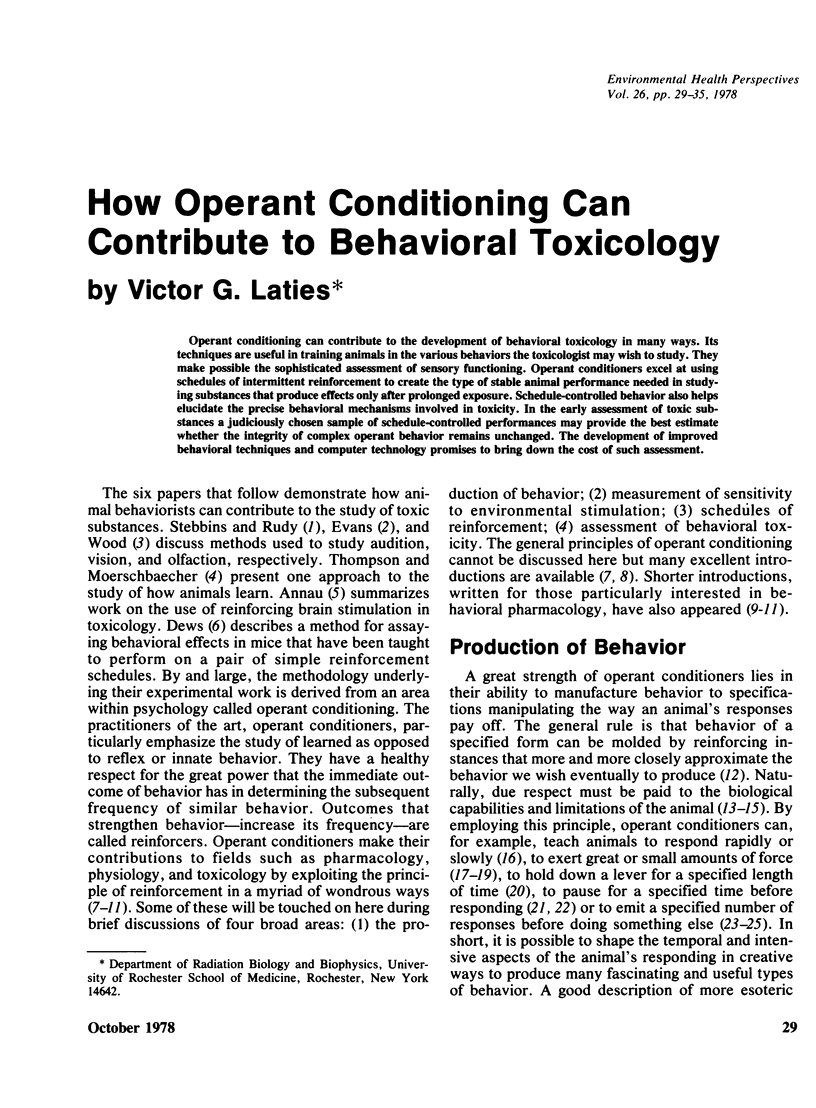

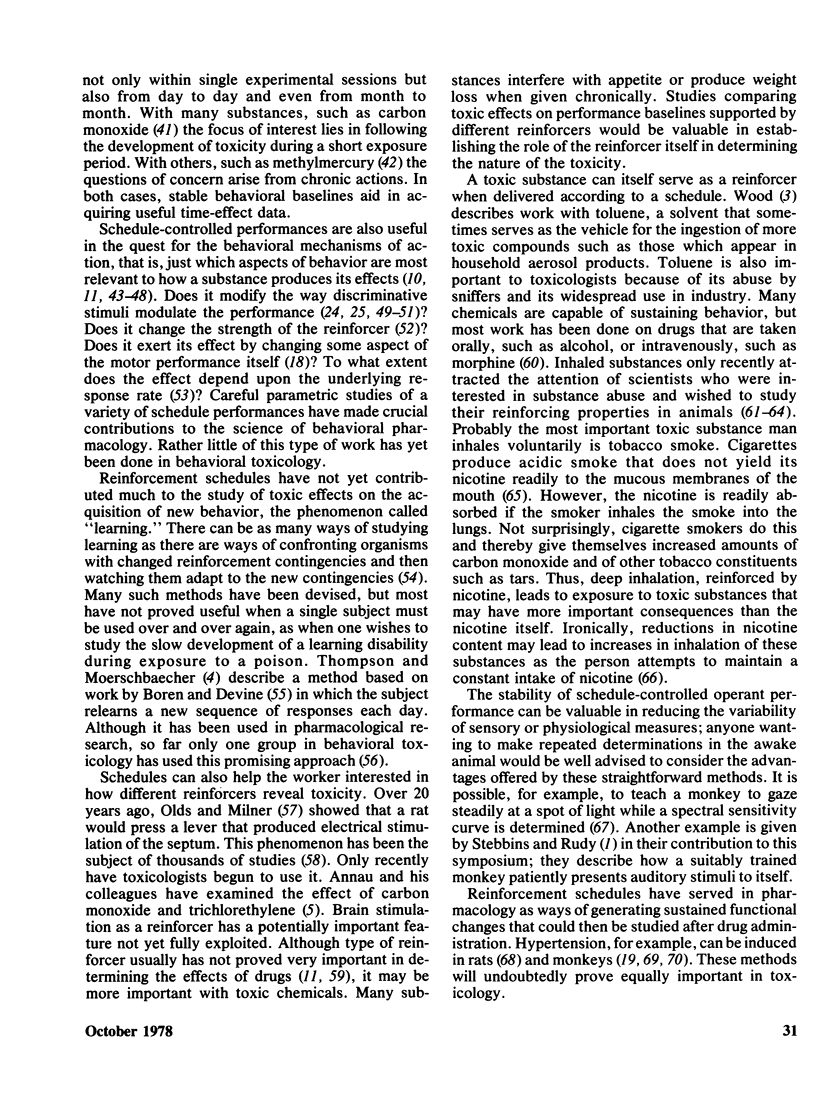

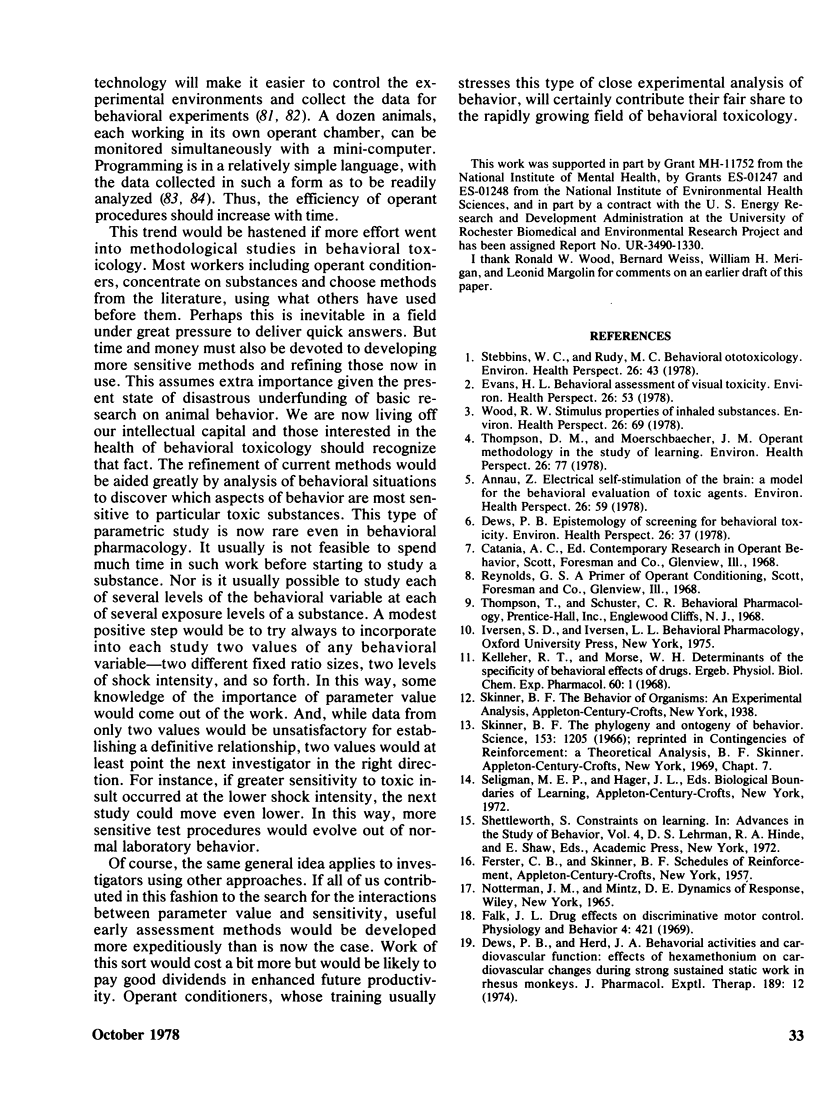
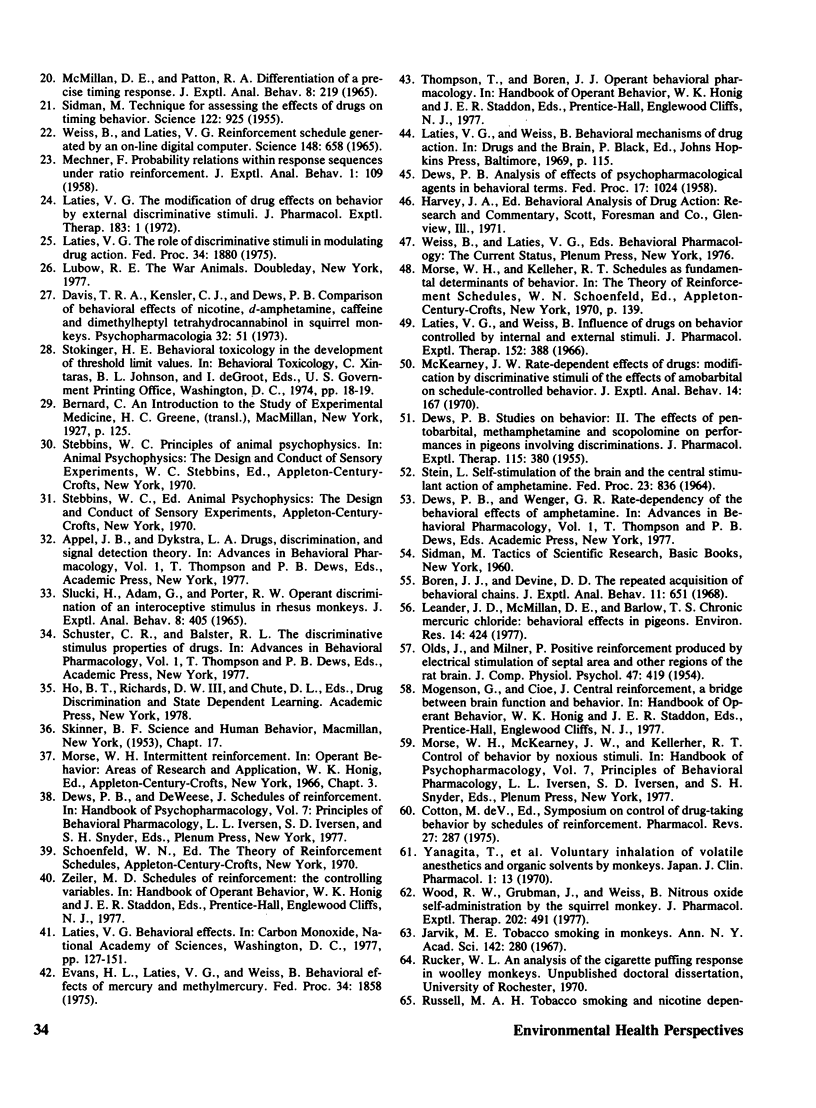
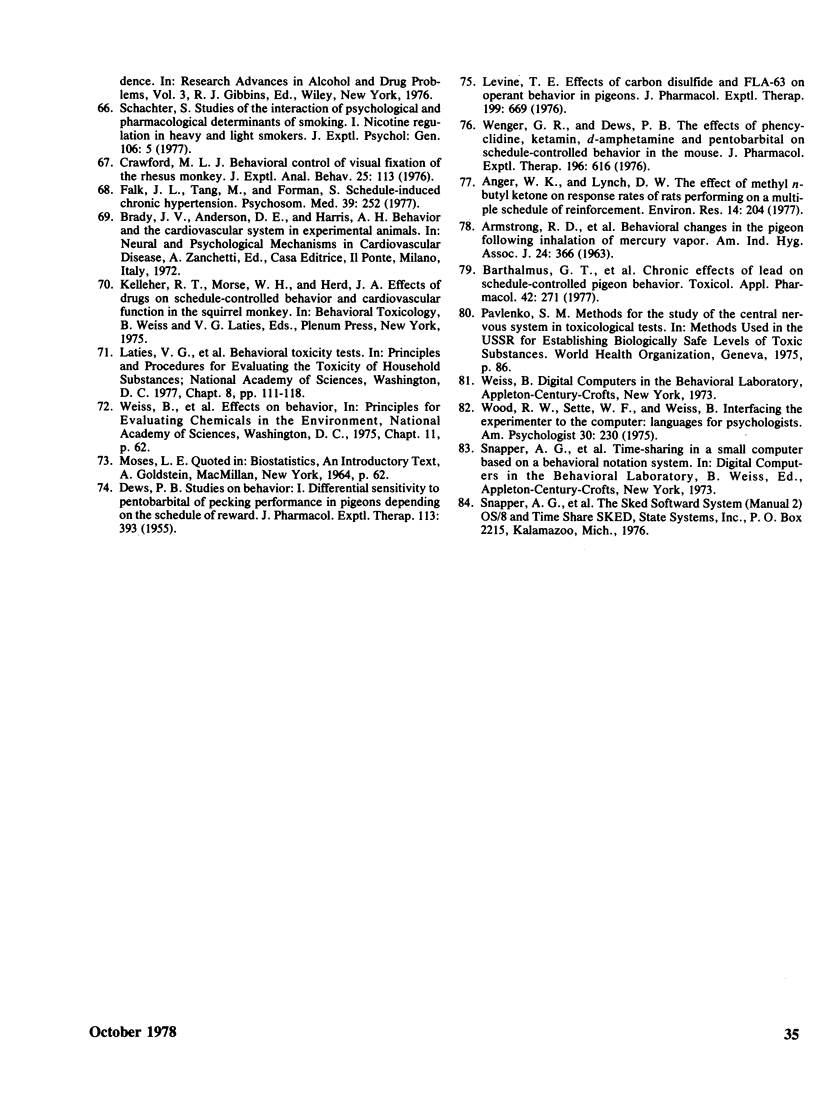
Selected References
These references are in PubMed. This may not be the complete list of references from this article.
- ARMSTRONG R. D., LEACH L. J., BELLUSCIO P. R., MAYNARD E. A., HODGE H. C., SCOTT J. K. BEHAVORIAL CHANGES IN THE PIGEON FOLLOWING INHALATION OF MERCURY VAPOR. Am Ind Hyg Assoc J. 1963 Jul-Aug;24:366–375. doi: 10.1080/00028896309343231. [DOI] [PubMed] [Google Scholar]
- Anger W. K., Lynch D. W. The effect of methyl n-butyl ketone on response rates of rats performing on a multiple schedule of reinforcement. Environ Res. 1977 Oct;14(2):204–211. doi: 10.1016/0013-9351(77)90032-9. [DOI] [PubMed] [Google Scholar]
- Annau Z. Electrical self-stimulation of the brain: a model for the behavioral evaluation of toxic agents. Environ Health Perspect. 1978 Oct;26:59–67. doi: 10.1289/ehp.782659. [DOI] [PMC free article] [PubMed] [Google Scholar]
- Barthalmus G. T., Leander J. D., McMillan D. E., Mushak P., Krigman M. R. Chronic effects of lead on schedule-controlled pigeon behavior. Toxicol Appl Pharmacol. 1977 Nov;42(2):271–284. doi: 10.1016/0041-008x(77)90004-7. [DOI] [PubMed] [Google Scholar]
- Boren J. J., Devine D. D. The repeated acquisition of behavioral chains. J Exp Anal Behav. 1968 Nov;11(6):651–660. doi: 10.1901/jeab.1968.11-651. [DOI] [PMC free article] [PubMed] [Google Scholar]
- Crawford M. L. Behavioral control of visual fixation of the rhesus monkey. J Exp Anal Behav. 1976 Jan;25(1):113–121. doi: 10.1901/jeab.1976.25-113. [DOI] [PMC free article] [PubMed] [Google Scholar]
- DEWS P. B. Analysis of effects of psychopharmacological agents in behavioral terms. Fed Proc. 1958 Dec;17(4):1024–1030. [PubMed] [Google Scholar]
- DEWS P. B. Studies on behavior. I. Differential sensitivity to pentobarbital of pecking performance in pigeons depending on the schedule of reward. J Pharmacol Exp Ther. 1955 Apr;113(4):393–401. [PubMed] [Google Scholar]
- DEWS P. B. Studies on behavior. II. The effects of pentobarbital, methamphetamine and scopolamine on performances in pigeons involving discriminations. J Pharmacol Exp Ther. 1955 Dec;115(4):380–389. [PubMed] [Google Scholar]
- Davis T. R., Kensler C. J., Dews P. B. Comparison of behavioral effects of nicotine, d-amphetamine, caffeine and dimethylheptyl tetrahydrocannabinol in squirrel monkeys. Psychopharmacologia. 1973 Aug 22;32(1):51–65. doi: 10.1007/BF00421707. [DOI] [PubMed] [Google Scholar]
- Dews P. B. Epistemology of screening for behavioral toxicity. Environ Health Perspect. 1978 Oct;26:37–42. doi: 10.1289/ehp.782637. [DOI] [PMC free article] [PubMed] [Google Scholar]
- Dews P. B., Herd J. A. Behavioral activities and cardiovascular functions: effects of hexamethonium on cardiovascular changes during strong sustained static work in rhesus monkeys. J Pharmacol Exp Ther. 1974 Apr;189(1):12–23. [PubMed] [Google Scholar]
- Evans H. L. Behavioral assessment of visual toxicity. Environ Health Perspect. 1978 Oct;26:53–57. doi: 10.1289/ehp.782653. [DOI] [PMC free article] [PubMed] [Google Scholar]
- Evans H. L., Laties V. G., Weiss B. Behavioral effects of mercury and methylmercury. Fed Proc. 1975 Aug;34(9):1858–1867. [PubMed] [Google Scholar]
- Fak J. L., Tang M., Forman S. Schedule-induced chronic hypertension. Psychosom Med. 1977 Jul-Aug;39(4):252–263. doi: 10.1097/00006842-197707000-00006. [DOI] [PubMed] [Google Scholar]
- Kelleher R. T., Morse W. H. Determinants of the specificity of behavioral effects of drugs. Ergeb Physiol. 1968;60:1–56. doi: 10.1007/BFb0107250. [DOI] [PubMed] [Google Scholar]
- Laties V. G. The modification of drug effects on behavior by external discriminative stimuli. J Pharmacol Exp Ther. 1972 Oct;183(1):1–13. [PubMed] [Google Scholar]
- Laties V. G. The role of discriminative stimuli in modulating drug action. Fed Proc. 1975 Aug;34(9):1880–1888. [PubMed] [Google Scholar]
- Laties V. G., Weiss B. Influence of drugs on behavior controlled by internal and external stimuli. J Pharmacol Exp Ther. 1966 Jun;152(3):388–396. [PubMed] [Google Scholar]
- Leander J. D., McMillan D. E., Barlow T. S. Chronic mercuric chloride: Behavioral effects in pigeons. Environ Res. 1977 Dec;14(3):424–435. doi: 10.1016/0013-9351(77)90050-0. [DOI] [PubMed] [Google Scholar]
- Levine T. E. Effects of carbon disulfide and FLA-63 on operant behavior in pigeons. J Pharmacol Exp Ther. 1976 Dec;199(3):669–678. [PubMed] [Google Scholar]
- MCMILLAN D. E., PATTON R. A. DIFFERENTIATION OF A PRECISE TIMING RESPONSE. J Exp Anal Behav. 1965 Jul;8:219–226. doi: 10.1901/jeab.1965.8-219. [DOI] [PMC free article] [PubMed] [Google Scholar]
- McKearney J. W. Rate-dependent effects of drugs: modification by discriminative stimuli of the effects of amobarbital on schedule-controlled behavior. J Exp Anal Behav. 1970 Sep;14(2):167–175. doi: 10.1901/jeab.1970.14-167. [DOI] [PMC free article] [PubMed] [Google Scholar]
- Mechner F. Probability Relations within Response Sequences under Ratio Reinforcement. J Exp Anal Behav. 1958 Apr;1(2):109–121. doi: 10.1901/jeab.1958.1-109. [DOI] [PMC free article] [PubMed] [Google Scholar]
- OLDS J., MILNER P. Positive reinforcement produced by electrical stimulation of septal area and other regions of rat brain. J Comp Physiol Psychol. 1954 Dec;47(6):419–427. doi: 10.1037/h0058775. [DOI] [PubMed] [Google Scholar]
- SIDMAN M. Technique for assessing the effects of drugs on timing behavior. Science. 1955 Nov 11;122(3176):925–925. doi: 10.1126/science.122.3176.925. [DOI] [PubMed] [Google Scholar]
- STEIN L. SELF-STIMULATION OF THE BRAIN AND THE CENTRAL STIMULANT ACTION OF AMPHETAMINE. Fed Proc. 1964 Jul-Aug;23:836–850. [PubMed] [Google Scholar]
- Skinner B. F. The phylogeny and ontogeny of behavior. Contingencies of reinforcement throw light on contingencies of survival in the evolution of behavior. Science. 1966 Sep 9;153(3741):1205–1213. doi: 10.1126/science.153.3741.1205. [DOI] [PubMed] [Google Scholar]
- Slucki H., Adam G., Porter R. W. Operant discrimination of an interoceptive stimulus in rhesus monkeys. J Exp Anal Behav. 1965 Nov;8(6):405–414. doi: 10.1901/jeab.1965.8-405. [DOI] [PMC free article] [PubMed] [Google Scholar]
- Stebbins W. C., Rudy M. C. Behavioral ototoxicology. Environ Health Perspect. 1978 Oct;26:43–51. doi: 10.1289/ehp.782643. [DOI] [PMC free article] [PubMed] [Google Scholar]
- Thompson D. M., Moerschbaecher J. M. Operant methodology in the study of learning. Environ Health Perspect. 1978 Oct;26:77–87. doi: 10.1289/ehp.782677. [DOI] [PMC free article] [PubMed] [Google Scholar]
- WEISS B., LATIES V. G. REINFORCEMENT SCHEDULE GENERATED BY AN ON-LINE DIGITAL COMPUTER. Science. 1965 Apr 30;148(3670):658–661. doi: 10.1126/science.148.3670.658. [DOI] [PubMed] [Google Scholar]
- Wood R. W., Grubman J., Weiss B. Nitrous oxide self-administration by the squirrel monkey. J Pharmacol Exp Ther. 1977 Sep;202(3):491–499. [PubMed] [Google Scholar]
- Wood R. W. Stimulus properties of inhaled substances. Environ Health Perspect. 1978 Oct;26:69–76. doi: 10.1289/ehp.782669. [DOI] [PMC free article] [PubMed] [Google Scholar]


